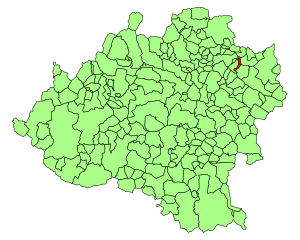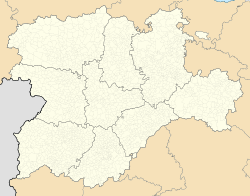Fuentestrún facts for kids
Quick facts for kids
Fuentestrún
|
|
|---|---|
 |
|
 |
|
| Country | |
| Autonomous community | |
| Province | |
| Municipality | Fuentestrún |
| Area | |
| • Total | 9 km2 (3 sq mi) |
| Population
(2018)
|
|
| • Total | 40 |
| • Density | 4.4/km2 (11.5/sq mi) |
| Time zone | UTC+1 (CET) |
| • Summer (DST) | UTC+2 (CEST) |
Fuentestrún is a very small village, also known as a municipality, located in the province of Soria in Spain. It is part of the Castile and León region. A municipality is like a local government area. It includes the main village and any nearby land or smaller settlements. Fuentestrún is a quiet, peaceful place with a very small population.
In 2004, about 78 people lived in Fuentestrún. By 2018, this number had decreased to just 40 people. This makes Fuentestrún one of the smallest municipalities in the Soria province.
Contents
Where is Fuentestrún?
Fuentestrún is located in the northern part of Spain. It is in the province of Soria. This province is known for its beautiful natural landscapes. It has mountains, forests, and rivers. The village is part of the larger region of Castile and León. This is one of Spain's 17 autonomous communities.
Geography and Landscape
The municipality covers an area of about 9 square kilometers. This is roughly the size of 900 football fields. The area around Fuentestrún is mostly rural. This means it has lots of open land, farms, and natural spaces. You might see rolling hills and traditional Spanish countryside.
The elevation of Fuentestrún is not specified in detail. However, many villages in Soria are located in hilly or mountainous areas. This gives them beautiful views and fresh air.
Life in a Small Village
Living in a very small village like Fuentestrún is different from living in a big city. There are fewer people and less traffic. Life tends to be quieter and more relaxed.
Community and Traditions
In small villages, people often know each other very well. They might share strong community bonds. Local traditions and festivals are very important. These events bring everyone together. They help keep the village's history alive.
Economy and Jobs
The economy in small rural areas often depends on farming. People might grow crops or raise animals. Other jobs could be in local services. These services include small shops or maintenance work. Tourism might also play a small role. Visitors come to enjoy the peace and nature.
History of Fuentestrún
Like many old villages in Spain, Fuentestrún has a long history. Its name likely comes from Spanish words. "Fuente" means "fountain" or "spring." This suggests there might have been an important water source nearby.
Historical Changes
Over many centuries, villages like Fuentestrún have seen many changes. They have survived wars and economic shifts. The population has changed over time. Many young people have moved to bigger cities for work. This is why the population has become smaller.
Climate in Soria
The Soria province has a continental climate. This means it has cold winters and warm summers. In winter, temperatures can drop below freezing. Snowfall is common. Summers are usually sunny and warm. However, they are not as hot as in southern Spain.
Seasons and Nature
Each season brings different beauty to Fuentestrún. Spring brings green fields and blooming flowers. Summer is perfect for outdoor activities. Autumn shows off colorful leaves. Winter covers the landscape in snow. This makes it a peaceful, white wonderland.
See also
 In Spanish: Fuentestrún para niños
In Spanish: Fuentestrún para niños



